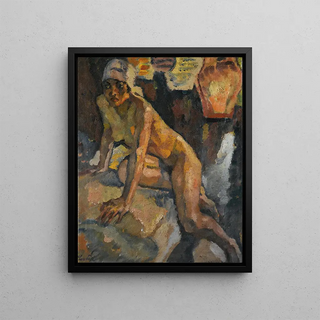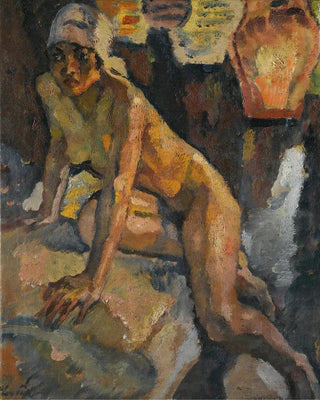Art print | At the Serail - Leo Putz


View from behind

Frame (optional)
In the fascinating world of art, some works manage to transcend time and space, captivating minds and hearts. "Au Sérail" by Leo Putz is undoubtedly one of those iconic pieces that evoke an atmosphere of exoticism and mystery. This painting, rich in colors and emotions, transports the viewer to a universe where beauty and sensuality intertwine. Through this art print, one can appreciate the virtuosity of the artist and his skill in capturing fleeting moments of life. The work presents itself as an invitation to explore the depths of the human soul, while offering a fascinating glimpse into Eastern cultures that greatly inspired European artists in the early 20th century.
Style and uniqueness of the work
The piece "Au Sérail" stands out for its bold style and vibrant palette. Leo Putz, master of decorative painting, manages to create an atmosphere that is both intimate and grandiose. The female figures, elegantly draped, seem to flourish in a space bathed in light, while the oriental motifs add a touch of exoticism that draws the eye. The composition is carefully orchestrated, with each element harmoniously arranged to create a captivating visual dynamic. The play of light and shadow, as well as the use of warm colors, evoke a palpable sensuality, inviting the viewer to feel the emotions of the characters depicted. This painting is a true ode to feminine beauty, where every detail contributes to a rich and evocative visual narrative.
The artist and his influence
Leo Putz, born in 1869 in Germany, is a painter whose artistic journey is marked by an incessant quest for beauty and harmony. Influenced by the Symbolist movement and Orientalist currents of his time, Putz was able to incorporate these elements into his own style, creating a unique and recognizable work. His interest in the Orient and its cultures is reflected in several of his creations, including "Au Sérail". The artist also came into contact with emblematic figures of his era, which enriched his artistic vision. By integrating

Matte finish

View from behind

Frame (optional)
In the fascinating world of art, some works manage to transcend time and space, captivating minds and hearts. "Au Sérail" by Leo Putz is undoubtedly one of those iconic pieces that evoke an atmosphere of exoticism and mystery. This painting, rich in colors and emotions, transports the viewer to a universe where beauty and sensuality intertwine. Through this art print, one can appreciate the virtuosity of the artist and his skill in capturing fleeting moments of life. The work presents itself as an invitation to explore the depths of the human soul, while offering a fascinating glimpse into Eastern cultures that greatly inspired European artists in the early 20th century.
Style and uniqueness of the work
The piece "Au Sérail" stands out for its bold style and vibrant palette. Leo Putz, master of decorative painting, manages to create an atmosphere that is both intimate and grandiose. The female figures, elegantly draped, seem to flourish in a space bathed in light, while the oriental motifs add a touch of exoticism that draws the eye. The composition is carefully orchestrated, with each element harmoniously arranged to create a captivating visual dynamic. The play of light and shadow, as well as the use of warm colors, evoke a palpable sensuality, inviting the viewer to feel the emotions of the characters depicted. This painting is a true ode to feminine beauty, where every detail contributes to a rich and evocative visual narrative.
The artist and his influence
Leo Putz, born in 1869 in Germany, is a painter whose artistic journey is marked by an incessant quest for beauty and harmony. Influenced by the Symbolist movement and Orientalist currents of his time, Putz was able to incorporate these elements into his own style, creating a unique and recognizable work. His interest in the Orient and its cultures is reflected in several of his creations, including "Au Sérail". The artist also came into contact with emblematic figures of his era, which enriched his artistic vision. By integrating






